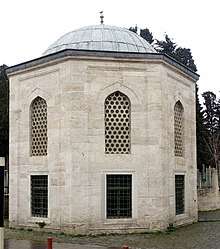Şekerpare Hatun
Şekerpare Hatun (Ottoman Turkish: شکر پارہ خاتون) was a lady-in-waiting to Sultan Ibrahim of the Ottoman Empire.
Şekerpare Hatun | |
|---|---|
| Died | Egypt, Ottoman Empire |
| Spouse(s) | Kara Musa Pasha |
| Religion | Sunni Islam |
Career
Şekerpare, who was previously known as Şehsuvar, began her career as the Hazinedar Usta (treasurer) of the imperial harem.[1] She was later appointed Kethüde Hatun (mistress housekeeper).[2]
In 1644 the Grand vizier Kemankeş Mustafa Pasha's standing was threatened by a powerful faction which was controlling the appointment and dismissal of certain individuals, even enriching its members in the process. This party included Şekerpare as well as Ibrahim's other male favourites.[3] Mustafa Pasha was executed and Ibrahim appointed his favourite Sultanzade Mehmed Pasha as the new Grand Vizier.[2]
It was known that Ebezade Hamide Hatun, wife of Hasan Pasha, the governor of Aleppo, was a friend of Şekerpare Hatun.[2]
Personal life
In 1647, Şekerpare married Grand vizier Kara Musa Pasha,[1] and because of her, he was appointed to the position of Grand Admiral. The treasure of Egypt was lavished on Ibrahims favourite wives and women, which also included Şekerpare.[4] A house was also bought for her.[5] In early 1648 she endowed a fountain in Istanbul,[6] and commissioned the building of her own mausoleum at Eyüp.[7] After Ibrahim's deposition in 1648, women of Ibrahim's harem were sent to the Old Palace. However, Şekerpare Hatun was exiled to Egypt.[2] The mausoleum that she had commissioned remained empty.[7]

References
- Sakaoğlu 2008, p. 353.
- Sakaoğlu 2008, p. 354.
- A ́goston & Masters 2010, p. 263.
- Çelebi & Erkılıç 1954, p. 62.
- Perice 1993, p. 317.
- Tanışık 1945, p. 219.
- Haskan 2008, p. 542.
Sources
- Peirce, Leslie P. (1993). The Imperial Harem: Women and Sovereignty in the Ottoman Empire. Oxford University Press. ISBN 978-0-195-08677-5.
- Sakaoğlu, Necdet (2008). Bu mülkün kadın sultanları: Vâlide sultanlar, hâtunlar, hasekiler, kadınefendiler, sultanefendiler. Oğlak Yayıncılık. ISBN 978-9-753-29623-6.CS1 maint: ref=harv (link)
- Çelebi, Evliya; Erkılıç, Süleyman Cafer (1954). Turk Klasikleri - Issue 34.CS1 maint: ref=harv (link)
- A ́goston, Ga ́bor; Masters, Bruce Alan (May 21, 2010). Encyclopedia of the Ottoman Empire. Infobase Publishing. ISBN 978-1-438-11025-7.CS1 maint: ref=harv (link)
- Tanışık, İbrahim Hilmi (1945). İstanbul çeşmeleri: Beyoğlu ve Üsküdar cihetleri. Maarif Matbaası.CS1 maint: ref=harv (link)
- Haskan, Mehmet Nermi (2008). Eyüp Sultan tarihi - Volume 2. Eyüp Belediyesi Kültür Yayınları. ISBN 978-9-756-08704-6.CS1 maint: ref=harv (link)
External links
- "Şekerpare Hatun" (in Turkish). Ottoman Bank Archives.